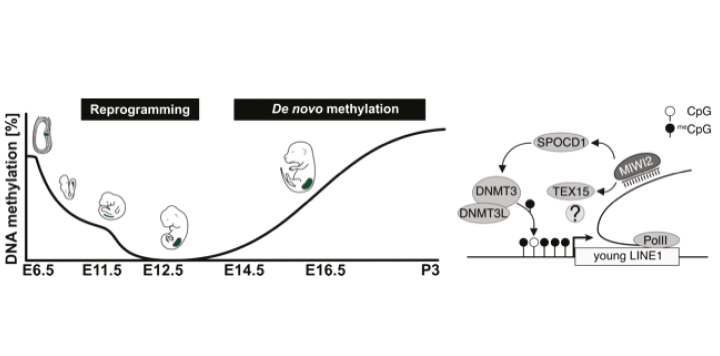Donal O'Carroll
Regulation of gene expression by non-coding RNA and RNA modification

After graduating in biochemistry from Trinity College Dublin, Dónal O’Carroll performed his PhD studies in the laboratory of Thomas Jenuwein at the Research Institute for Molecular Pathology (IMP) in Vienna. Thereafter he joined The Rockefeller University as a postdoctoral fellow and research associate with Alexander Tarakhovsky. In 2007, Dónal moved to the European Molecular Biology Laboratory (EMBL) in Rome as a group leader.
Donal joined the University of Edinburgh in 2015 as the Chair of Stem Cell Biology. Since 2015 he has been the Head of the Institute for Stem Cell Research and Associate Director of the Centre for Regenerative Medicine. In 2018 he also became a group leader at the Wellcome Centre for Cell Biology.
The O’Carroll laboratory studies the mammalian germline from an RNA perspective. His laboratory couples advanced mouse genetics with state-of-the-art sequencing approaches to explore the PIWI-interacting RNA (piRNA) and RNA modification pathways.
Lab members
Shaunak Burse, Tamoghna Chowdhury, Hannah Fieler, Madeleine Heep, Yuka Kabayama, Gabriela Konieczny, David MacLeod, Martina Schito, Theresa Schoepp and Ansgar Zoch
Regulation of gene expression by non-coding RNA and RNA modification
The O’Carroll laboratory has a longstanding interest in mechanisms that regulate gene and transposon expression. Using the germline and haematopoiesis as model systems, our research explores the importance and molecular mechanisms of regulatory RNA pathways in dynamic developmental and physiological contexts. We currently focus on the PIWI-interacting RNA (piRNA) and RNA modification pathways.
The piRNA pathway
In mammals, the acquisition of the germline from the soma provides the germline with an essential challenge, the necessity to erase and reset genomic methylation. This is one of the most drastic epigenetic events in mammalian life. De novo genome methylation re-encodes the epigenome, imprinting and transposable element (TE) silencing. In the male germline piRNA-directed DNA methylation silences young active TEs. Antisense TE-derived piRNAs generated from intricate biogenesis pathways act to guide the nuclear PIWI protein MIWI2 to instruct TE DNA methylation. piRNAs are proposed to tether MIWI2 to the young transcriptionally active TE loci that escape the first phase of genome methylation by base pairing to nascent transcripts. The recruitment of MIWI2 sets in motion TE silencing and methylation through the recruitment of unknown effector molecules. Recently we have found the first such effectors of nuclear MIWI2 function. Both SPOCD1 and TEX15 interact with MIWI2 and are essential for piRNA-directed DNA methylation (Nature 2020 and Nature Communications 2020). SPOCD1 interacts with the de novo methylation machinery, whereas the molecular function of TEX15 remains unknown. Our future goal is to fully understand the mechanism by which MIWI2 instructs TE methylation and epigenetic silencing (Figure 1).
RNA modification
The role of RNA modification in the post-transcriptional regulation of gene expression is only beginning to be understood. The O'Carroll laboratory focuses on understanding the function of N6-methyladenosine (m6A) and 3' terminal uridylation mRNA modifications, both of which can promote RNA degradation. TUT4 and TUT7 mediate 3' uridylation of mRNAs with short poly(A) tails that primes these transcripts for degradation, whereas the binding of YTHDF2 to m6A-modified mRNA promotes transcript decay. We have shown critical functions for these pathways in the metabolism of the maternal transcriptome and oocyte competence. We have also demonstrated that YTHDF2 is overexpressed in multiple sub-types of acute myeloid leukaemia (AML) and its deletion selectively compromises cancer stem cells, without grossly perturbing normal haematopoiesis (Cell Stem Cell 2019). We are currently exploring basic questions regarding the mechanism, regulation and redundancy of the YTH domain family of m6A readers.

Genomic DNA methylation is erased (reprogramming) and reset (de novo methylation) during germ cell development. Our current model of MIWI2-piRNA directed TE methylation based on functionally defined interactions is presented.
Selected publications
Zoch, A., Auchynnikava, T., Berrens, R. V., Kabayama, Y., Schöpp, T., Heep, M., Vasiliauskaité, L., Pérez-Rico, Y. A., Cook, A. G., Shkumatava, A., Rappsilber, J., Allshire, R. C., & O'Carroll, D. (2020). SPOCD1 is an essential executor of piRNA-directed de novo DNA methylation. Nature, 10.1038/s41586-020-2557-5. https://doi.org/10.1038/s41586-020-2557-5
Schöpp, T., Zoch, A., Berrens, R. V., Auchynnikava, T., Kabayama, Y., Vasiliauskaité, L., Rappsilber, J., Allshire, R. C., & O'Carroll, D. (2020). TEX15 is an essential executor of MIWI2-directed transposon DNA methylation and silencing. Nature Communications, 11(1), 3739. https://doi.org/10.1038/s41467-020-17372-5
Paris J, Morgan M, Campos J, Spencer GJ, Shmakova A, Ivanova I, Mapperley C,Lawson H, Wotherspoon DA, Sepulveda C, Vukovic M, Allen L, Sarapuu A, Tavosanis A, Guitart AV, Villacreces A, Much C, Choe J, Azar A, van de Lagemaat LN,Vernimmen D, Nehme A, Mazurier F, Somervaille TCP, Gregory RI, O'Carroll D*, Kranc KR*. Targeting the RNA m(6)A Reader YTHDF2 Selectively Compromises Cancer Stem Cells in Acute Myeloid Leukemia. Cell Stem Cell. 2019 Apr 24. pii:S1934-5909(19)30120-1. doi: 10.1016/j.stem.2019.03.021. * co-corresponding authors

